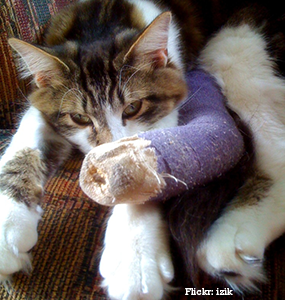Kelly Serfas, a Certified Veterinary Technician in Bethlehem, PA, contributed to this article.
Surgery and anesthesia are not exact sciences. Even the most common surgery can lead to unanticipated problems. Following your vet’s recommendations for pet care after surgery is important to improve our chances of a happy ending. This should at least ensure that we avoid preventable complications.
As promised in our first installment, here are five more tips to ensure a successful outcome after your pet’s surgery.
6. Elimination
Make sure you are available to take your dog outside, especially if they need to be walked with a sling. If your cat is confined, you may need to purchase another litter box specifically for this one kitty.
7. Medications
After surgery, your pet will typically go home with pain medications and antibiotics. It is important to finish all medications. They will keep your pet comfortable and help avoid infections. Pets, by nature, are good at hiding their pain. So just because your pet does not seem painful, please think of how much pain you or a friend were in after a major abdominal, orthopedic or dental procedure.
8. Food
Your vet may recommend a special food depending on your pet’s needs. For example, there are diets designed to prevent bladder stones from coming back. Others are designed to lose or maintain weight. Nutrition is very important for proper healing after surgery. Your pet should be eased slowly into that new food in order to improve acceptance and to decrease the risk of diarrhea.
Vets often recommend a 10 day transition. What does this mean?
Day 1: Feed 100% of the current food and 0% of the new food.
Day 2: Feed 90% of the current food and 10% of the new food.
Day 3: Feed 80% of the current food and 20% of the new food.
Continue this pattern so that after 10 days your pet only eats the new food.
Even if your pet is has an ideal weight, I often suggest decreasing the amount of food by 25% to prevent weight gain during confinement. Otherwise, eating the same amount of food while being confined, i.e. while needing fewer calories, will lead to weight gain.
9. Rehabilitation
Depending on the type of orthopedic surgery, your vet may recommend a physical therapy protocol. In its simplest form, this involves putting a joint through a full range of motion (flexion and extension). Some exercises can be done at home, while others can only be done with a professional at a rehab practice.
10. TLC
Tender loving care is as essential as any of our other suggestions for postop care. Your pet is going through tough times and has no idea what is going on. Worse: pets don’t understand that we are trying to help them.
Few employers will give you time off of work when your pet needs surgery, so you may not be available during the day. You might be able to have a family member or a friend check on them, let them out, (hand) feed them and possibly them give medications on schedule. When you are home, spend as much time as possible with your pet. Even when they are confined, you can sit with them, pet them, brush them, It can be helfpul to have a play pen or gates/doors that you can easily move your pet to areas where you will be spending time (such as moving them to the family room while you are watching tv, the bedroom, not on the bed, but in their pen on the floor, to the kitchen as you cook, and so on).
By following these 5 simple tips (in addition to our previous 5) you should be able to avoid 90% of the frequent problems we see in surgery and general practice.
If you have any questions or concerns, you should always visit or call your veterinarian – they are your best resource to ensure the health and well-being of your pets.
